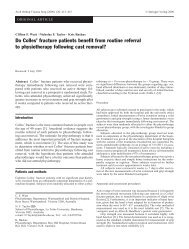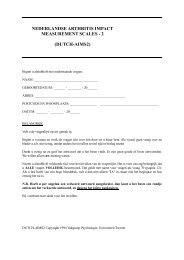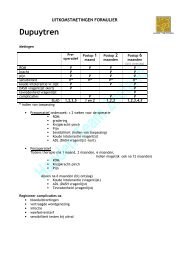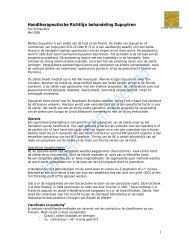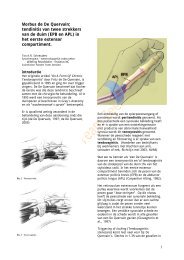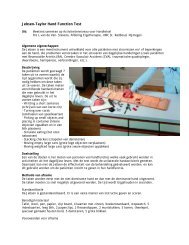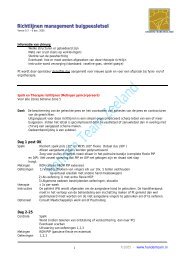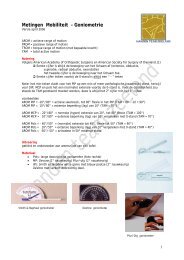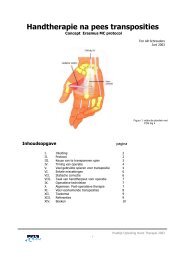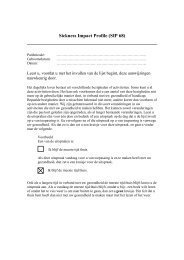Muscle strength measurements of the Hand - Handen Team Zeeland
Muscle strength measurements of the Hand - Handen Team Zeeland
Muscle strength measurements of the Hand - Handen Team Zeeland
You also want an ePaper? Increase the reach of your titles
YUMPU automatically turns print PDFs into web optimized ePapers that Google loves.
Ton A.R. Schreuders, JW Brandsma, HJ Stam<br />
<strong>the</strong> normal finger, <strong>the</strong> lateral bands shift<br />
dorsally and towards <strong>the</strong> central position <strong>of</strong><br />
<strong>the</strong> finger when <strong>the</strong> PIP joint is extended.<br />
Whereas when flexing <strong>the</strong> PIP joint <strong>the</strong><br />
dorsal expansion needs to allow <strong>the</strong> lateral<br />
bands to move volarly towards <strong>the</strong> flexionextension<br />
axis <strong>of</strong> movement. When this<br />
dorsal expansion is elongated, <strong>the</strong> lateral<br />
bands are too much volarly, resulting in a<br />
loss <strong>of</strong> PIP joint extension. Consequently,<br />
<strong>the</strong> oblique retinacular ligament (ORL) or<br />
Landsmeers ligament is slack most <strong>of</strong> <strong>the</strong><br />
time and will adjust to this new situation by<br />
shortening and this may result in<br />
hyperextension <strong>of</strong> <strong>the</strong> DIP joint. This is a<br />
similar progression <strong>of</strong> changes as in an<br />
extensor tendon central slip injury, causing<br />
a Boutonnière deformity. 4<br />
FIGURE 3. Thomas sign: compensation<br />
movement when interossei muscles are weak;<br />
flexion <strong>of</strong> <strong>the</strong> wrist in an attempt to gain a<br />
better opening <strong>of</strong> <strong>the</strong> hand, i.e. by means <strong>of</strong><br />
increasing <strong>the</strong> pull on <strong>the</strong> EDC.<br />
Ano<strong>the</strong>r impairment in longstanding<br />
paralyses <strong>of</strong> <strong>the</strong> interossei muscles is<br />
related to hyperextension <strong>of</strong> <strong>the</strong> MCP joint.<br />
This causes an upward pull <strong>of</strong> <strong>the</strong> EDC<br />
tendons (bow stringing), stretching <strong>the</strong><br />
sagittal bands. The laxity <strong>of</strong> <strong>the</strong> sagittal<br />
bands will result in an inability to maintain<br />
<strong>the</strong> EDC tendon on top <strong>of</strong> <strong>the</strong> MCP joint.<br />
The drop <strong>of</strong> <strong>the</strong> luxating tendon into <strong>the</strong><br />
groove between <strong>the</strong> MCPs is especially<br />
observable when flexing <strong>the</strong> MCP joint.<br />
This is sometimes called “guttering”<br />
because <strong>the</strong> tendon drops into <strong>the</strong> “gutter”<br />
between <strong>the</strong> MCP joints.<br />
The longstanding flexed position <strong>of</strong><br />
<strong>the</strong> IP joints will result in a physiological<br />
shortening <strong>of</strong> <strong>the</strong> long flexors. This flexor<br />
tightness will increase <strong>the</strong> PIP flexion<br />
position and can cause a deterioration <strong>of</strong><br />
<strong>the</strong> PIP flexion contractures. This is an<br />
additional argument to maintain <strong>the</strong> length<br />
<strong>of</strong> <strong>the</strong> extrinsic flexors in patients with<br />
intrinsic muscle weakness.<br />
Shortening <strong>of</strong> <strong>the</strong> interossei<br />
muscles is called intrinsic tightness (IT),<br />
which can be caused by a trauma <strong>of</strong> <strong>the</strong><br />
hand which can precipitate a cascade <strong>of</strong><br />
events. The interossei are situated in<br />
ra<strong>the</strong>r tight compartments, <strong>the</strong>refore<br />
oedema/swelling will cause an increase <strong>of</strong><br />
pressure in <strong>the</strong>se compartments.<br />
As a result blood circulation will be<br />
hampered causing anoxia and muscle<br />
fiber death, which results in fibrosis <strong>of</strong> <strong>the</strong><br />
muscle and shortening. This is identical to<br />
<strong>the</strong> process which causes Volkmann's<br />
ischemic contracture in <strong>the</strong> forearm. 48<br />
The IT test consists <strong>of</strong> two parts.<br />
First, passive PIP flexion is tested with <strong>the</strong><br />
MCP joint extended and, secondly,<br />
passive PIP flexion is tested again but now<br />
with <strong>the</strong> MCP joint flexed. If <strong>the</strong>re is a<br />
large difference in PIP flexion between <strong>the</strong><br />
two MCP positions, intrinsic tightness is<br />
present. The long-term complications <strong>of</strong> IT<br />
can result in decreased MCP extension<br />
and a swan neck finger, i.e.<br />
hyperextension <strong>of</strong> <strong>the</strong> PIP joint. A<br />
longstanding swan neck deformity might<br />
result in a painful snapping <strong>of</strong> <strong>the</strong> lateral<br />
bands at PIP level when <strong>the</strong> finger is<br />
flexed.<br />
In rheumatoid arthritis a different<br />
process can also lead to IT. The role <strong>of</strong> <strong>the</strong><br />
intrinsic muscles in producing MCP<br />
subluxation in <strong>the</strong> rheumatoid hand has<br />
49 50<br />
been documented.<br />
Ano<strong>the</strong>r intricacy sometimes<br />
observed is what we call interosseous<br />
plus, which is a paradoxal extension: <strong>the</strong><br />
harder <strong>the</strong> patient tries to bend <strong>the</strong> finger,<br />
<strong>the</strong> more <strong>the</strong> finger will extend in <strong>the</strong> PIP<br />
joint. This phenomena is sometimes seen<br />
in patients in which <strong>the</strong> interossei have<br />
been <strong>the</strong> only flexor <strong>of</strong> <strong>the</strong> finger for some<br />
time e.g. in high median nerve palsy, or in<br />
case <strong>of</strong> adhered flexor tendons. Although<br />
<strong>the</strong> flexors are active and can bend <strong>the</strong><br />
finger, when a stronger grip is required <strong>the</strong><br />
finger will extend.<br />
8



